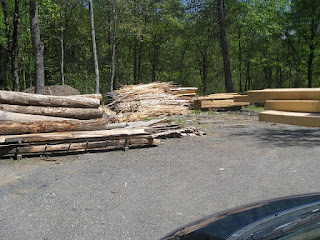One thing most people wonder about is where to find good wood for their boat-building project. Let me tell you it isn't always easy. Very often people wander into a "big box store" and wonder why they can't find what they are looking for. Simple. The big box is targeted at folks who are building homes, decks and sheds - not boat builders. This means you're going to need to look a bit harder.
Ok, so you head over to your "local" lumberyard that you found in the yellow pages. Chances are they've got some of the wood that you might be looking for. Perhaps a bit of Western Red Cedar or maybe some Douglas Fir, Cypress, Redwood and the like. Plywood will be in abundant supply, but not likely BS1088 marine grade plywood. Some brass hardware might be in evidence, a bit of stainless steel.
So now you delve a little bit deeper into the yellow pages. You find a hardwood or specialty lumber supplier and you can now get a wide variety of domestic and foreign hardwoods - perhaps even some marine grade plywood, too. Selection is usually decent, but the prices are somewhat high.
The next step is a difficult one for many woodworkers and boat builders, but usually a good one. Sometimes it's an advertisement, sometimes it is somewhere you see when you are out driving, sometimes it's word-of-mouth, but however you find out, you go to the source - the sawyer and the sawmill. Some sawmills are pretty permanent and organized operations like the one below. Some are a bit more "fly-by-night" - a portable bandsaw mill located at a timbering site. These are the connections that you want. The closer you can get to the growing tree, the cheaper the lumber usually is, and the better selection you will get.
In my case I was looking for Northern White Cedar which does not grow locally to me. However, I knew by word-of-mouth that this particular sawmill sold it - which surprised me. I called ahead to see if they had what I was looking for and drove up to the mill. The image below shows what I saw on arrival - logs, offcuts and stacks of lumber. All a good sign. The sawyer pointed me to a small stack of lumber about 10' from the saw. It was a jumbled-up mix of short, generally narrow stock that looked pretty nice. He also pointed to the pile to the right of the offcuts and said that I could look through both for what I needed - which was very kind of him. (Note the hood of the car in the lower right)
Immediately to the right of the car, was the planing mill and the pile was between the stack of lumber you see next to the car. I went through the pile and re-stacked it up on ties sorting it by width and length when I was done. I then went to the pile in the back and looked through that - re-stacking the lumber when I was done.
Considering the quality (and small quantity) of the stock that I bought, I was pretty pleased with the price - $3 a board foot. He was kind enough to lower the price from $3.50 to $3.00 for the longer stock I picked from the back pile because he was pleased that I had neatly re-stocked the lumber. He also commented that I was welcome to come up and pick through stock anytime I wished. I also took the time to speak with him about what he generally had to offer, how he seasoned his stock and how long the wood that I'd purchased had been milled and drying - all of this is nice information that you won't find in a lumberyard or big-box store. He also quoted me prices for other lumber he had - all at attractive prices and good quality.
The pile I selected from was to the right in this image behind the board. Can't get too much closer to the tree than 20' from the bandsaw mill! I later found out why they carried the stock I was looking for - they own mills in the northern part of the state where it grows and ship "local" stock from those mills south and vice-versa. It does pay to go to where the stock is cut and talk to the sawyer!

















No comments:
Post a Comment